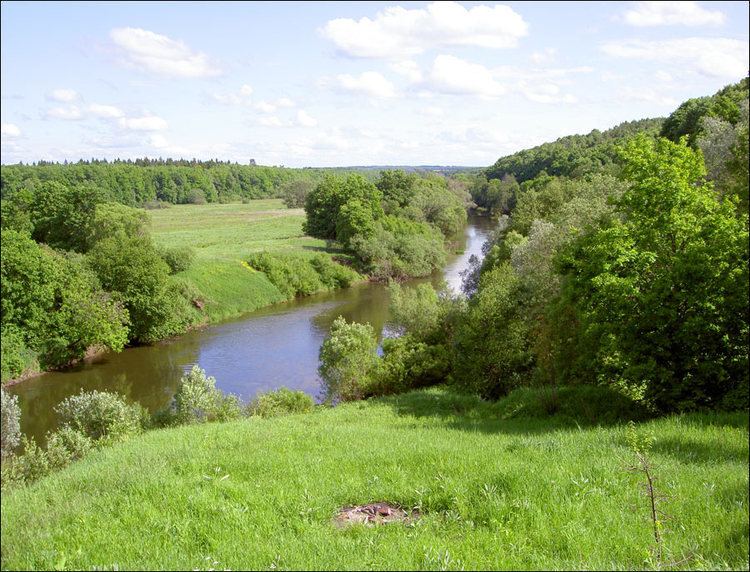Economic region Central Area 25,700 km² | Federal district Central Established September 26, 1937 Area rank 69th | |
 | ||
Clubs and Teams FC Arsenal Tula, Arsenal Tula, BC Tula-Shchekinoazot Colleges and Universities Tula State University, Tulskiy Artilleriyskiy Inzhener, Russian New University, Novomoskovsk Branch of the Unive Points of interest Yasnaya Polyana, Tula State Museum of Weapons, Museum "Tula samovars", Kulikovo Field, Tula Kremlin | ||
Tula Oblast (Russian: Ту́льская о́бласть, Tulskaya oblast) is a federal subject of Russia (an oblast) with its present borders formed on September 26, 1937. Its administrative center is the city of Tula. The oblast has an area of 25,700 square kilometers (9,900 sq mi) and a population of 1,553,925 (2010 Census preliminary results). The current governor of the oblast is Alexey Dyumin (since 2 February 2016).
Contents
- Map of Tula Oblast Russia
- History
- Geography
- Rivers
- Natural resources
- Climate
- Politics
- Demographics
- Religion
- Economy
- Culture
- References
Map of Tula Oblast, Russia
History
People have inhabited Tula area since ancient times, as shown by discoveries of burial mounds (kurgans) and old settlements. These lands were occupied by the Slavic Vyatichi tribe, who cultivated the land, traded, and worked at crafts. This is confirmed by records in property registers, which mention an "ancient settlement" located at the place where the small Tulitsa River flows into the Upa River. In those long-ago times, its inhabitants may also have defended their settlements against raids by Tatars and nomadic tribes, but history is silent on this matter. The first mention of Tula is found in Nikon's chronicle in reference to the campaign of Prince Svyatoslav Olgovich of Chernigov. The chronicle notes that in 1146, the prince, who was heading for Ryazan, passed through a number of other settlements, including Tula, which at the time belonged to the Ryazan Principality.
Geography
Tula Oblast is located in Russia's Central Federal District and borders Moscow, Ryazan, Lipetsk, Oryol, and Kaluga Oblasts.
Rivers
Tula Oblast contains more than 1,600 rivers and streams. Major rivers include:
Natural resources
The oblast is rich in iron ore, clay, limestone, and deposits of lignite (coal). The lignite deposit is part of the Moscow coal basin.
Climate
Tula Oblast has a moderate continental climate, with warm summers and cold winters. Average January temperature is −10 °C (14 °F) in north and −9 °C (16 °F) in south. Average July temperature is about +19 °C (66 °F) to +20 °C (68 °F). Annual precipitation is 470 millimetres (19 in) in southeast and 575 millimetres (22.6 in) in northwest.
Politics
During the Soviet period, the high authority in the oblast was shared between three persons: The first secretary of the Tula CPSU Committee (who in reality had the biggest authority), the chairman of the oblast Soviet (legislative power), and the Chairman of the oblast Executive Committee (executive power). Since 1991, CPSU lost all the power, and the head of the Oblast administration, and eventually the governor was appointed/elected alongside elected regional parliament.
The Charter of Tula Oblast is the fundamental law of the region. The Tula Oblast Duma is the province's standing legislative (representative) body. The Oblast Duma exercises its authority by passing laws, resolutions, and other legal acts and by supervising the implementation and observance of the laws and other legal acts passed by it. The highest executive body is the Oblast Government, which includes territorial executive bodies such as district administrations, committees, and commissions that facilitate development and run the day to day matters of the province. The Oblast administration supports the activities of the Governor who is the highest official and acts as guarantor of the observance of the oblast Charter in accordance with the Constitution of Russia.
Demographics
Population: 1,553,925 (2010 Census); 1,675,758 (2002 Census); 1,867,013 (1989 Census).
Ethnic composition (2010):
2009 - 1.31 | 2010 - 1.31 | 2011 - 1.32 | 2012 - 1.43 | 2013 - 1.42 | 2014 - 1.47 | 2015 - 1.57 | 2016 - 1.56(e)
Religion
According to a 2012 official survey 62% of the population of Tula Oblast adheres to the Russian Orthodox Church, 2% are unaffiliated generic Christians, 1% are Muslims. In addition, 19% of the population declares to be "spiritual but not religious", 13% is atheist, and 3% follows other religions or did not give an answer to the question.
Economy
Tula Oblast is part of the Central economic region. It is a prominent industrial center with metalworking, engineering, coalmining, and chemical industries. Major industrial cities include Novomoskovsk and Aleksin. Historical industries, such as firearm, samovar, and accordion manufacturing, still play an important role in the region.
The oblast also has a developed agricultural sector, which ranks 33rd in Russia in agricultural production. The sector includes farming grain (wheat and rye), potatoes, sugar beets, and vegetable growing, livestock raising, and dairying.
Culture
Tula Oblast has as many as 32 museums. Several are located in the administrative center of the oblast, the city of Tula, notably the Tula State Arms Museum, the Tula Kremlin, and the Tula Samovar Museum . Another important cultural tourist attractions is the home and country estate of Leo Tolstoy, Yasnaya Polyana, located 12 km outside of the city of Tula.
The oblast also has four professional theaters, a philharmonic orchestra, and a circus.
